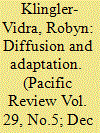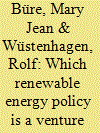|
|
|
Sort Order |
|
|
|
Items / Page
|
|
|
|
|
|
|
| Srl | Item |
| 1 |
ID:
148311


|
|
|
|
|
| Summary/Abstract |
Diffusion scholarship expects little adaptation of core elements of policy models. However, the empirical reality is different; diffusion of even highly regarded models, such as the Silicon Valley venture capital (VC) policy model, results in marked adaptation. This article demonstrates why the Silicon Valley VC model is necessarily adapted differently by policy-makers in the geographically, ethnically and economically proximate states of Hong Kong, Taiwan and Singapore. More specifically, these policy-makers' interventionist orientations, private sector financing preferences and international versus domestic firm promotion biases drive contextually rational – and unique – adaptations of the Silicon Valley VC policy model.
|
|
|
|
|
|
|
|
|
|
|
|
|
|
|
|
| 2 |
ID:
124706


|
|
|
|
|
| Publication |
2013.
|
| Summary/Abstract |
Deployment of marine renewable energy (MRE) in the UK is desirable in order to address climate change, meet mandatory EU renewable energy targets and provide significant economic development opportunities, including new export markets. Public funding constraints in the UK mean that substantial investment is required from the private sector to commercialize the industry. By focussing on investor attitudes and behaviours towards wave and tidal technologies, this paper reveals significant observations from the investment community with serious implications for the future of the MRE industry. Through a series of in-depth interviews with individuals from the investment community, device developers and industry support, the research seeks to identify common barriers and incentives to investment. The paper demonstrates that although investors' attitudes are generally aligned, they do appear to have changed over time. Of the participants that had previously invested in early stage MRE device development, none were likely to do so again. It is concluded that this is a function of investors' greater understanding of the scale, and unpredictability of the costs, and the length of time required to develop these technologies. This presents a significant policy challenge for all actors interested in the commercialization of wave and tidal technologies
|
|
|
|
|
|
|
|
|
|
|
|
|
|
|
|
| 3 |
ID:
111903


|
|
|
|
|
| Publication |
2012.
|
| Summary/Abstract |
The Office of the Chief Scientist (OCS) provides public financing for high tech Research and Development. This article describes the OCS and its evolution since 2000, and assesses the government's response to crises in venture capital financing during 2001-03 and 2008-10. It finds that the government's response was inadequate in 2001-03; the OCS budget was reduced, and essential reforms were adopted belatedly. In 2008-10, the picture is mixed; the OCS budget was increased in 2009, then reduced in 2010. In July 2010, the government proposed a comprehensive package of reforms, whose impact remains to be seen.
|
|
|
|
|
|
|
|
|
|
|
|
|
|
|
|
| 4 |
ID:
192373


|
|
|
|
|
| Summary/Abstract |
Financing sustainable growth has attracted global attention and discussion in recent years. This study investigates the effect of venture capital, as a potential source of sustainable finance, on air pollution in China from 2003 to 2016. Using the unique Government Guidance Fund as instrumental variable, we find that venture capital activities have significantly reduced local air pollution in cities of China. To be specific, a one standard deviation increase in the VC amount leads to 4% decrease in PM2.5 concentration and 6% reduction in industrial SO2 emission. The effects are insensitive to a wide range of robustness tests. Cities characterized by more rigorous environmental supervision, superior business environments, and stronger innovation incentives benefit more from venture capital activities. We further show that venture capital helps improve local air quality by boosting general and green innovation, increasing the investment of new green enterprises, as well as crowding out the investment of polluting industries.
|
|
|
|
|
|
|
|
|
|
|
|
|
|
|
|
| 5 |
ID:
193214


|
|
|
|
|
| Summary/Abstract |
In 2005, the Chinese government deployed a new financial instrument to accelerate technological catch-up: government guidance funds (GGFs). These are funds established by central and local governments partnering with private venture capital to invest in state-selected priority sectors. GGFs promise to significantly broaden capital access for high-tech ventures that normally struggle to secure funding. The aggregate numbers are impressive: by 2021, there were more than 1,800 GGFs, with an estimated target capital size of US$1.52 trillion. In practice, however, there are notable gaps between policy ambition and outcomes. Our analysis finds that realized capital fell significantly short of targets, particularly in non-coastal regions, and only 26 per cent of GGFs had met their target capital size by 2021. Several factors account for this policy implementation gap: the lack of quality private-sector partners and ventures, leadership turnover and the inherent difficulties in evaluating the performance of GGFs.
|
|
|
|
|
|
|
|
|
|
|
|
|
|
|
|
| 6 |
ID:
087770


|
|
|
|
|
| Publication |
2009.
|
| Summary/Abstract |
Existing typological frameworks do not adequately categorize terrorist groups by their operational characteristics. We propose a new framework which compares terrorist groups to business firms. In our framework, terrorist groups are mapped on two axes: centralization of resources and centralization of operations. We separate terrorist groups into four typologies echoing familiar business arrangements: Hierarchy, Venture Capital, Franchise, and Brand. Responses to each typology are briefly sketched out. We conclude by analyzing the changes in Al Qaeda over the last two decades in the context of our framework. We close by proposing appropriate policy responses to combat Al Qaeda in light of its current Brand typology.
|
|
|
|
|
|
|
|
|
|
|
|
|
|
|
|
| 7 |
ID:
092725


|
|
|
|
|
| Publication |
2009.
|
| Summary/Abstract |
Governments around the world have adopted ambitious targets to increase the share of renewable energy and reduce greenhouse gas emissions. They pursue a variety of policy approaches to achieve these targets. It has been a popular theme for contributions in Energy Policy to investigate the effectiveness of such policies. This article adds a new perspective to the debate, namely looking at the policy preferences of private investors in innovative clean energy technology firms. We surveyed 60 investment professionals from European and North American venture capital and private equity funds and asked them to assess the effectiveness of various policies, in terms of stimulating their interest to invest in innovative clean energy technologies. In addition to quantitative rankings, we use qualitative interview data to capture additional information on why investors prefer some policies over others. The combined analysis compensates for the inherent limitations of a quantitative ranking using generic policy types. The results of this exploratory analysis demonstrate that, all other things being equal, investors in our sample perceived feed-in tariffs to be the most effective renewable energy policy. The overall preference for feed-in tariffs is even more pronounced among investors based in Europe and with higher exposure to clean energy.
|
|
|
|
|
|
|
|
|
|
|
|
|
|
|
|
|
|
|
|
|